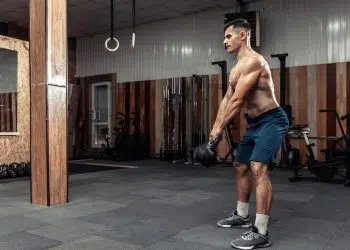What You’ll Takeaway –
1. In simple terms a periodized training program is devised by taking into account an athletes off-season, pre-season, in-season and recovery. It is a logical sequencing of training with predetermined time points based on goals.
2. Training is devised looking at the workout, micro, meso and macro cycle.
3. There are many different ways to periodize a program; linear, non-linear and block.
4. De-load period can be used during any cycle, with the hope of when the athlete does return to a higher volume of training performance continues to increase.
5. For the newbie or general gym going individual looking to lose weight periodization is probably not needed. Working out looking to increase strength through progressive over load, by primarily increasing workout volume (reps x sets x load) each week will suffice, and bring a good amount of progress.
I want to explain the term and training cycle of periodization. When I first started training back at Uni for rugby I just did a number of random exercises performing a random number of sets normally of 10 reps. I wish I had understood and followed a properly researched programme of periodization as this would have meant a huge progression towards the competitive season compared to what I was doing!
Level Up Your Fitness: Join our 💪 strong community in Fitness Volt Newsletter. Get daily inspiration, expert-backed workouts, nutrition tips, the latest in strength sports, and the support you need to reach your goals. Subscribe for free!
Periodization training has shown to be more effective than complete randomized programmes (e.g. some Crossfit workouts) by Rhea and Alderman in 2004 (1) and this is why I want to share this info with you.
The main goal of periodization is to optimize recovery and minimize overtraining, while evoking a performance effect to improve your competitive/performance capability.
In my opinion, periodization is key for a powerlifting/weighting athlete with a specific goal, competition and deadline in mind. You need a set structured routine, consisting of relevant exercises to optimise your in season performance.
The Cycles –
In simple terms a periodized training program is devised by taking into a count an athletes off-season, pre-season, in-season and recovery. It is a logical sequencing of training with predetermined time points based on goals.
Specific cycles have been devised that describe training ranging from a day to 4 years (seen below) and the specific type of training within each of these cycles would vary depending on where they fall within the overall training plan.
Workouts – The workout should consist of relevant exercises specific to your long term goals. However, you should also have a short term workout goal to aid motivation and compliance!
Micro Cycle – A training block of 1 week within the meso cycle
The micro cycle is accumulation of a number of workouts over a week. A specific micro cycle can be an introduction to the larger meso cycle, teaching a client or athlete specific movements or tips. A specific weeks training could also be tailored to a run up to a competition or match.
Meso Cycle – A training block of approx. 4-6 weeks
This cycle is made up of many micro cycles designed around one specific purpose. Most programs use this cycle to develop one component of fitness such as strength, power, endurance or some other physical ability.
Macro Cycle – Training plan of around a year
The macro cycle consists of an annual plan and therefore includes all aspects of a periodized training program out season, pre season, in season and recovery. Because of its length, you will almost certainly make changes to it throughout the year.
Quadrennial Cycle – A plan of more than 4 years
Long term plans of 4 years in length often used by Olympians.
*It is important to realise that the duration of the cycles mentioned are not set in stone and differ from individual, athlete requirements and sport.
How does a periodized program look?
There are many different ways to periodize a program; linear, non-linear and block.
Linear periodization is the process of increasing intensity (weight lifted relative to 1RM) while volume (reps and sets) decreases over a set cycle, normally of 12 weeks long. This can then be followed by a subsequent cycle with increased volume. While, non-linear or undulating periodization is the process of altering variables (reps, sets and loads) over a short period of time, a week for example.
For this article I am going to look at block periodization; the programming of 3 distinctive mesocycle blocks of training ending with a weightlifting/powerlifting competition. Typically used by to develop performance and skills, over different blocks of training within a training cycle of 12 weeks.
Block periodization was first devised by Dr. Yuri Verkhoshansky (2) where he proposed a style of programming that concentrated on becoming more specific as the competition draws nearer.
A block periodized program for an athlete will revolve around his date of competition.
Accumulation –
During this phase, the athlete will look to improve on his physique/performance especially on his/her weak parts which were highlighted at his last comp. Typically a hypertrophy phase and 1-6 weeks in length, this will build a foundation and therefore different athletes may have different training due to their needs during this phase.
Training will be tailored to contain relevant exercises to assist him in his goals. The athlete will look to develop work capacity, their general physic along with technical aspects of his competition, building a solid foundation. The intensity of training is low, but the volume is high. The work during this block will have a greater amount of less specific movements, to their competition.
Level Up Your Fitness: Join our 💪 strong community in Fitness Volt Newsletter. Get daily inspiration, expert-backed workouts, nutrition tips, the latest in strength sports, and the support you need to reach your goals. Subscribe for free!
Transmutation –
As the athlete gets closer to his competition, training will become more specific depending on progress and the individual. Typically 2-4 weeks, the length and start date of this phase will all depend on the athlete and his/her’s progression. In this phase abilities are transferred to specific movements and intensity increases while the volume is reduced, looking to increase strength.
Realization –
The final stage is a taper or peaking block, also know as realization. The volume is low and the intensity is high (approx 90% of his 1RM.) During this block, the training is directed to the competition lifts. This peaking process is used to make ensure ‘optmal’ performance is reached for the competition. This block of training is followed by a de-load period in order to make sure the athlete is filled recovered and ready to compete.
Post-comp will be his/her recovery, normally in the form of tailored training and nutrition, to help with any injuries or health problems and get back into the off season, building on previous achievements.
Yearly Design –
Obviously a cycle of training over a complete year, whether it be for an amateur or professional, should always be devised and conducted by someone with sufficient knowledge. However, let me share some of my own points to be considered. An important point when setting up any training cycle is to always asses your starting point and progress as there is no cycle that will fit all. Therefore, you should always be willing to making slight adjustments in training, if needed, to make sure you’re not hitting a plateau and get the most out of it individually.
Too often variation of training is either limited or changed far too much. This is why I stress it is important to always track and keep a log of both training and diet so small changes can be made. Your body is adapting with every workout, so using the same number of sets and reps with the same weight week in week out, isn’t ‘optimal.’ It may get results for a newbie for a few weeks but soon you will stall. It should always be about progressing no matter what your goal is.
However, having said this variation in exercises, reps, sets etc. should never be excessive or random. It should always be crafted to specific goals or an area of weakness.
Is a de-load period needed?
A de-load period can be used during any cycle, with the hope of when the athlete does return to a higher volume of training performance continues to increase.
A de-load period could last anywhere up 2 weeks depending on the athletes needs and could consist of a reduction in intensity, volume or frequency of training, leading to increased recovery. If a de-load week is taken it is important to still train with the same dedication and commitment to keep the muscle activation pathways stimulated and keep the muscles moving through a full range of motion.
Do not worry you will not lose strength or size!
This period of time does not have to be planned in advance, say every 4 weeks. They can be taken spontaneously or based on feedback from a coach or your recovery.
Is a periodized program essential?
For the newbie to the gym, someone wanting to lose fat, or even an experienced lifter who isn’t competitive, no probably not. As we know the best workout program is going to be the one someone can enjoy and stick to. Always looking to get stronger over time and progressively over loading your muscles, by primary increasing workout volume (reps x sets x load) over time. Training in a variety of rep ranges and using a variety of exercises.
This type of approach will provide the best progress and suffice the majority of the population.
Greg Nuckols wrote a good article on this, titled ‘More is more.’
Here is a quote from his article –
‘Essentially, if you’re getting stronger, don’t fix what isn’t broken. If you’re not getting stronger, assuming you aren’t feeling worn down all the time, do more.
That could take a few different forms:
1) sticking with your current program, but doing more work sets or adding drop sets
2) starting or increasing accessory work targeting specific weaknesses
3) adding more work for your stalled lift on another day of the week
The amount of work you do doesn’t need to double overnight, but if you look through your training journals and see that a lift has been stalled for a year, and you’re doing the same amount of work for that lift today as you were doing a year ago, you’ve probably found your culprit.’
But obviously as a lifter becomes more experienced, or starts to compete in a specific field, periodized cycles may be needed to ‘optimize’ progress and performance. This is because as we become more and more experienced at lifting our body becomes more accustomed to training and lifting.
The body is always attempting to stay as is, while you want it to get stronger or bigger. It therefore takes a sufficient amount of continual stress applied to the body to cause an adaptation. Therefore, the demand we need to apply through training becomes more specific and of higher magnitude the more and more we train.
References –
1. Rhea, MR and Alderman, BL. (2004) A meta-analysis of periodized versus nonperiodized strength and power training programs, Res Q Exerc Sport, vol. 75(4), pp. 413-22.
2. http://www.udel.edu/ICECP/resources/periodization/Organization%20of%20the%20training%20process.pdf








